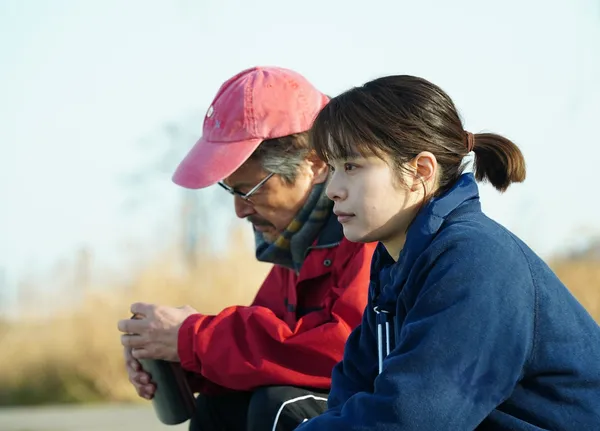Eye For Film >> Movies >> Small, Slow But Steady (2022) Film Review
Small, Slow But Steady
Reviewed by: Dora Leu

Shô Miyake’s Small, Slow But Steady (Keiko, Me Wo Sumasete) is a rare breed of a sports film. Composed, meditative and, ultimately, sensitive, the usual aesthetics of boxing as spectacular and drenched in adrenaline are abandoned in favour of a silent study of ritualistic gestures, more reminiscent of Frederick Wiseman’s Boxing Gym (2010) than of bombastic pop-culture achievements like Rocky. Miyake is not concerned with that greater-than-life, climatic feeling of overcoming your opponent, but with the sporadic nature of finding the will to fight – in sport, and in life.
Based on Keiko Ogasawara’s autobiographical Makenaide! (i.e. Don’t lose/Don’t give up), the film follows recently turned pro-fighter Keiko Ogawa (Yukino Kishii) as she trains in a small, run-down, once prestigious gym on one secluded, yet scenic street in Tokyo. Keiko was born Deaf, and as her coach (veteran actor Tomokazu Miura) explains at one point to a curious journalist, this is often a costly disadvantage in boxing. She cannot hear the bell, nor the referee. In many ways, in the ring, it’s only her and her own self. "But since she is successful, does this mean she has a special talent?" asks the journalist. Her coach doesn’t seem to want to acknowledge she does; Keiko simply trains hard and is diligent. It may, in fact, be that Keiko is no sporting revelation at all. She might be winning now and she might be losing later.

While Keiko does stand out as the only female in the gym, and among the few in an otherwise generally male-coded sport, the film does not ostentatiously speculate on her differences or impairments. Miyake ends up cleverly rejecting the facile expectation of a disadvantaged underdog surpassing all the obstacles and coming out triumphant. We are not asked to pity Keiko, nor to root for her. Instead, as the title aptly suggests, it is the “slow but steady” that interests the director, following the young woman through her daily training routines in a portrait of minute and prolonged dedication, which at times may get too tiring.
Kishii shines in understanding the rhythmic metrics of boxing, but also in depicting Keiko as a sensible mixture of restraint and vivid introspection. The young woman remains mostly opaque throughout the film, but not inexpressive. There is little we factually find out about the boxer – she works a cleaning job in an expensive hotel, lives with her brother and may have taken up boxing after being bullied when she was younger. But more than that Keiko keeps to herself, from us as an audience, and from the people around her.
Altogether sparse in dialogue, for Small, Slow But Steady it is the boxing which becomes a form of communication. Keiko mimicking her coach’s moves and her silently sparring with her other two trainers strengthen bonds where words are unnecessary. Observing only movement, Miyake’s steady camera and its picturesque images allow for moments that could easily be referred to as pure cinema. Transcendental is often a pretentious word, but Miyake’s cadenced, Ozu-reminiscent, directorial style has a talent for sensing tensions and charging shots with profound meaning and sereneness.
The director’s take on communication also extends to how he integrates sign language into the film. I am not trying to point out that it may be a gesture of inclusivity, but rather that Miyake pays great attention to (cinematic) language and to the tensions between expression and the inability to express. What Keiko signs is translated to us as an audience via captions or subtitles, but there are times, such as when the young woman is with other Deaf friends, where we have no intermediation.
What we have access to and what we can understand is, ingeniously and perhaps also transgressively, arbitrary. Miyake seems to overall make an interesting point about what in cinema is necessary (or not) to be verbalised or communicated directly. Sometimes, an image like seeing Keiko alone on her kitchen floor will tell us enough, without any word. A hint of meta-cinematic musings might also stretch to Miyake’s interest for secondary media, such as the recordings of Keiko’s fights that get replayed over and over, and her mother’s pictures of her.
Yet perhaps what is most transgressive about Small, Slow But Steady is, counterintuitively, its style. Miyake’s stylistic maturity and adherence to a nostalgic, richly textured and coloured 16mm goes against the grain of a clean and ‘proper’ image so much of recent Japanese cinema has adopted, including even Cannes darlings like Hirokazu Kore-eda or Naomi Kawase. The director’s choice for an older cinematic style not only infuses the space of the worn down gym with a wistful aura of a time gone by but creates subtle dialogue between the nature of the image and a Tokyo so clearly set in the 2020s – a modernity which we have rarely seen on film.
Small, Slow But Steady encapsulates this convergence of a waning past and an aggressive present also through the fate of Keiko’s boxing gym, as the pandemic forces it to close down. Here Miyake may have sneaked in a tacit political commentary on the struggles the pandemic has forced onto small businesses and the working class. With Keiko’s two trainers working in the gym as a second job and with her coach’s declining health, there seems to exist a traditional, more idealistic, but compassionate way of doing things that will soon be lost in the face of the more professional, better equipped, yet corporate and possibly lacking in empathy new gyms.
The key message here might be that, in the end, grand sporting achievements may matter less than the people who help you achieve them. For Keiko, it seems that her trainers’ gleeful support and their silent comradeship cannot be traded for any fancy equipment, even if they might help her win more.
Small, Slow But Steady’s slow pace and placid tone provide for an unexpectedly comforting experience. Its picturesque gym, seen in Ozu-like architectured shots, stands as a palace of universal human connection that goes beyond words. The director may not be that old, but the film excels in finding a certain maturity that could perhaps one day make it a modern classic. Miyake’s stylised undertaking at a sports film that is not brash or overly kinetic certainly makes him one voice of recent Japanese cinema that it would be well to pay attention to and certainly one of the best that Japanese art cinema has to offer.
Reviewed on: 21 Feb 2022
















